The Fundamentals of Making Nachos
Nachos are one of my guilty pleasures. I'm almost embarrassed about making them. A lasagna isn't healthy for you. It may have some tomatoes in it and cudos for eating fruit in something. But let's be real: lasagna isn't a health food by any stretch of the imagination! It's predominantly noodles and cheese.
So, what really makes nachos all that different from lasagna?
Nachos primarily consist of tomatoes, chips, and cheese. From a pure calculation of unnecessary fats, carbohydrates, and sodium content? They're pretty on par. There's nothing healthy about nachos or lasagna. And, quite frankly, they are pretty much made up of the same ingredients.
But lasagna is a production. It takes hours to put together. Even a pre-prepared, quick lasagna still cooks for an hour in the oven. This makes the indulgence seem worth it. It makes the calories seem worth it! If for no other reason than you had to work for them.
Nachos take 15 minutes, tops. Even if you bypass the microwave and bake them in the oven, you'd still be hard pressed to make nachos in more than 15 minutes! They're quick and easy and I have a hard time justifying what's essentially late night junk food.
Now, I probably can't compare eating nachos to eating an entire chocolate cake (also a decadent production and well worth it on occasion!), but I do consider cheese a junk food. It's not a meal. It has very little nutritional value aside from calcium (which you can just as easily get from beans, legumes, and dark greens). And let's not even get started on the mild lactose issue most of us deal with.
What ARE Nachos?
The origin of nachos is actually quite a fun one because there is a historical record of the very first nachos. They were originally invented in 1943 by Ignacio "Nacho" Anaya, who was working at a restaurant in Piedras Negras, Mexico when 10 or 12 of the military wives from a nearby military base in Eagle Pass, Texas. He couldn't find the cook and decided to simply tossed everything that he had on hand onto some tortillas and voila! A new snack was born. His son later recounted the story as,
My father was maître d' and he said 'Let me go quick and fix something for you.' He went into the kitchen, picked up tostadas, grated some cheese on them -- Wisconsin cheese, the round one -- and put them under the salamander (a broiler that quickly browns foods). He pulled them out after a couple minutes, all melted, and put on a slice of jalapeño.
Ignacio Anaya Jr. in The Sun Sentinal's The Legend of the Nacho's Appetizer
I rather enjoy this story. Although, working as a cook in the restaurant industry for about 15 years now? I would be both amused and flabbergasted that a host would dare to actually try and touch anything in my realm of the kitchen. Although I also wouldn't leave an entire kitchen unattended! And I truly do not know how I would have survived without nachos in my life. So, I will forever be grateful for the happy accident of nachos and the quintessential leftover food that it is!
My Passion for Nachos
Nevertheless, I am a sucker for nachos! There's something nostalgic about childhood. One of my favorite restaurants growing up was Kell's, a little Irish pub with absolutely delicious soda bread to start. But, being a picky eater and not the most carnivorous of children, I would always just get the nachos! They were your typical pub food nachos with Tillamook cheddar, tomatoes, red & green onions, black olives & sour cream. What made them stand apart, though, was that the tortilla chips weren't really tortilla chips. They were just house fried potato chips with all of the fixings on top.
And now I'm absolutely obsessed with the most decadent nachos imaginable for a small child!
Now, as I got older and started going during the night hours for the fish and chips with a drink, live music, and cigar bar. But there is still something mouthwatering about those nachos that will always be unparalleled in my mind.
Plus, who doesn't just enjoy a good plate of nachos sometimes??
The Oven or Microwave Debate?
I don't own a microwave. So, I'm firmly in the oven category! However, there is absolutely nothing wrong with microwaving nachos and I have absolutely done it in the past. There are some pros and cons to both.
Microwave
Pros: The best argument for the microwave method is how quick it cooks the nachos. Three to five minutes in the microwave and you're done! It also tends to melt the ingredients into one another more efficiently. Microwaves rapidly heat so there's less time for cheese or other ingredients to harden. You're not going to get that problem where you go to grab a chip and the entire plate of nachos comes with it!
Cons: Although the cheese won't harden on top and cause the ingredients to stick together in one giant pile of nachos, this does happen because all of the ingredients rapidly melt into one another. This can leave you with soggy, rubbery chips. If you overload them, you may also end up with the problem where the cheese on top is melted, but the inside of the nachos is still cold. Microwaves have less of an even heat and can create hot spots, especially on top, where the cheese may even begin to bubble and burn. This can cause the oil and fat to separate and seep out, creating a pool of unappealing liquified cheese fat to congeal at the bottom of the plate.
Oven
Pros: The best argument for the oven method is how the chips toast as the cheese on the nachos melts. When you have both top and bottom heat, it's more likely that the nachos are going to cook evenly. This firms up the chips and helps prevent them from getting soggy during the cooking process. You also aren't as likely to get hot spots where the cheese on top melts too quickly and burns. If you time it right with a high heat, you may even be able to get some light browning on the cheese.
Cons: While microwaves run the risk of soggy nachos, oven-baked nachos have the opposite problem. Nachos with lower moisture contents and/or harder cheeses tend to dry out during a longer cooking process. There is also the noteworthy additional amount of dishes involved. You're going to need a baking sheet, spatula, and a plate. One of my biggest unexpected issues with oven-baked nachos is also portion control. Microwaved nachos are self-sizing. You can only load up a microwave-sized plate so much! But, when presented with an entire sheet pan? Oh do I certainly make too much sometimes!
Generally speaking, I would say that quicker and dryer nachos are best made in the microwave. While, toastier and more ingredient-rich nachos are best made in the oven. With only a 5-10 minute time difference and only slightly more cleanup involved in the oven, I am slightly biased towards oven-baked nachos. I also have no other choice because I sold my microwave almost 10 years ago. But, at the end of the day, it really is a matter of personal preference! Do what works best for you and enjoy.
How to Make Nachos Gourmet
These days, if I'm going to make nachos, I'm going to get a little fancy about it. And, if not fancy, at least use every single leftover in my refrigerator! That's actually my primary purpose for making nachos most of the time: to utilize hoards of leftovers all at once in a quick and easy recipe that also satisfies my cheese craving.
The key to elevating nachos is really just getting past the basics and utilizing anything and everything in the same general flavor profile. Nachos in my home at least usually consisted of refried beans, tomatoes, onions, olives, cheese, and a hefty dollop of sour cream.
Rice & Beans
Rice and refried beans are a good staple, but a lot of other beans and legumes mimic a similar flavor and texture. Lentils, rice, curry, tofu, and anything with a rich and creamy consistency are great. I'll even throw in homemade hummus, roasted squash purée, and quinoa sometimes as the base.
Fruits & Vegetables
Produce, like tomatoes, onions, and olives are still fantastic options. Really, any fruits and vegetables are great. From where I'm concerned, the more the better! A lot of the time I'll throw in whatever I have, from garlic and shallots to cherry tomatoes and avocados. Homemade guacamole, shredded lettuce, and jalapeños are also great options.
Cheese
Cheese is another fun thing to play with. My go-to is white cheddar and queso fresco, but any soft to medium cheese is ideal. Harder cheeses, like parmesan aren't great because they don't melt as well into the nachos. Paneer also tends to hold its shape and obviously won't melt, but does add a nice flavor and acts much like tofu.
Most cheeses that you have on hand, though, are great. Everything from provolone, gouda, and mozzarella to blue cheese and even brie are delicious. Homemade nacho cheese is also an option. Just avoid pre-shredded cheese. It has an anti-caking agent that prevents it from sticking together and this makes it more difficult to melt. You can use it if you want, but it won't have the same consistency as cheese that isn't pre-shredded.
Sour Cream
Sour Cream also is a fairly solid staple in any nacho recipe. I tend to use a bit more Greek yogurt than I do sour cream, though. Greek yogurt tends to be a little bit thicker consistency and more flavorful as sour cream. I find that it pairs better with Mediterranean, Middle Eastern, and Asian flavor profiles than sour cream. It also tends to be lower in calories, fat, and lactose. If you really want to get fancy with it, crème fraîche and tzatziki are also divine.
Hot Sauce
Hot sauce and salsa aren't something that I've mentioned so far, but are also incredibly noteworthy as their own section! I enjoy spicy food and any dip, salsa, enchilada sauce, or hot sauce of choice is a great addition.
What to Make w/ Nachos
I make most of my nachos late at night after a long day. They might be quick to toss together and probably do consist of literally have everything in my refrigerator at the time! But this great way to utilize leftovers is still one of my favorites and always will be!

The Fundamentals of Making Nachos
Equipment
- Oven
- Baking Sheet
Ingredients
- ~2 handfulls tortilla chips
- 1/2 c. refried beans (or other bean or legume base)
- 1/2 c. fresh produce (or other toppings of choice)
- 1/2 c. cheese
- hefty dollop sour cream (or Greek yogurt)
- dollop hot sauce (or salsa of choice)
Instructions
- Preheat oven to 350 degrees Fahrenheit.
- Meanwhile, lay out tortilla chips across a baking sheet. You want to cover until you can't see the baking sheet any longer. They should be touching, but not overlapping too much. You really just want to be able to add toppings to every chip without it getting too much on the baking sheet.Two handfuls also isn't an exact measurement, but it does portion it to roughly your own size. I'm 5'1" and have relatively small hands. I also don't need an absolutely gigantic plate of nachos! Someone who's a foot taller than me with larger hands? Probably wants a bigger plate of nachos than I do. And I've found the two handfuls size to be a pretty good gauge. Plus, no one making nachos is sitting around trying to fit chips into a measuring cup or breaking out a scale to do it in grams!
- Add refried beans or whatever you're using as base.With softer ingredients, it's nice to take a knife and lightly spread them across each chip. This is a little bit more time consuming, but ensures that you get an even coating of toppings with every bite. It also adds a distinct layer between the wetter ingredients on top, like tomatoes and cheese, and the chips that might be susceptible to getting soggy.
- Spread additional toppings and fresh produce evenly across the chips.
- Sprinkle with cheese.
- Add small dollops of sour cream/Greek yogurt and hot sauce/salsa of choice.This is optional at this stage. Some people like the sour cream and hot sauce to slowly cook into the nachos. Others prefer them cold and crisp on top, especially with a spicier nacho. Personally, I oscillate between the two. It's entirely a matter of personal preference!
- Bake for 10 minutes, or until the cheese melts and the chips begin to toast.
- Once the nachos are done cooking, remove from the oven and top with any additional ingredients.The majority of fresh ingredients I like to cook in the nachos. However, a select few don't fair as well when cooked! Avocados and shredded lettuce tend to soften and brown in an unpleasant way. Sometimes it's nice to get a fresh tomato or green onion on top. Also add sour cream and hot sauce, if you haven't already.
- Serve immediately. Once the nachos begin to cool down, the tortilla chips will absorb too much moisture and soften. Once this happens, there isn't a lot that you can do to crisp them up again!
Tips, Tricks, & Notes
- It is incredibly difficult to reheat nachos. I'd dare to say probably not possible in the microwave in any kind of edible way. The chips absorb moisture as they sit and will inevitably get soggy. I do sometimes have leftovers, though, and endeavor to reheat them on occasion!
- The best way that I've found to do this is to leave the nachos on the counter so that they get a little stale. Skip this step if the ingredients are highly perishable or remove ingredients, like avocados, that won't keep.
- Then, preheat oven to 400 degrees Fahrenheit. Add a handful of chips on top and bake for another 10 minutes. The top layer of chips keeps the cheese and toppings from burning while the bottom chips toast and adds a little bit more crispness if the bottom chips remain soggy.
- It's not foolproof and flipping the nachos upside down so that the fresh chips are on the bottom and the soggy chips are on the top can also help. But it does work.
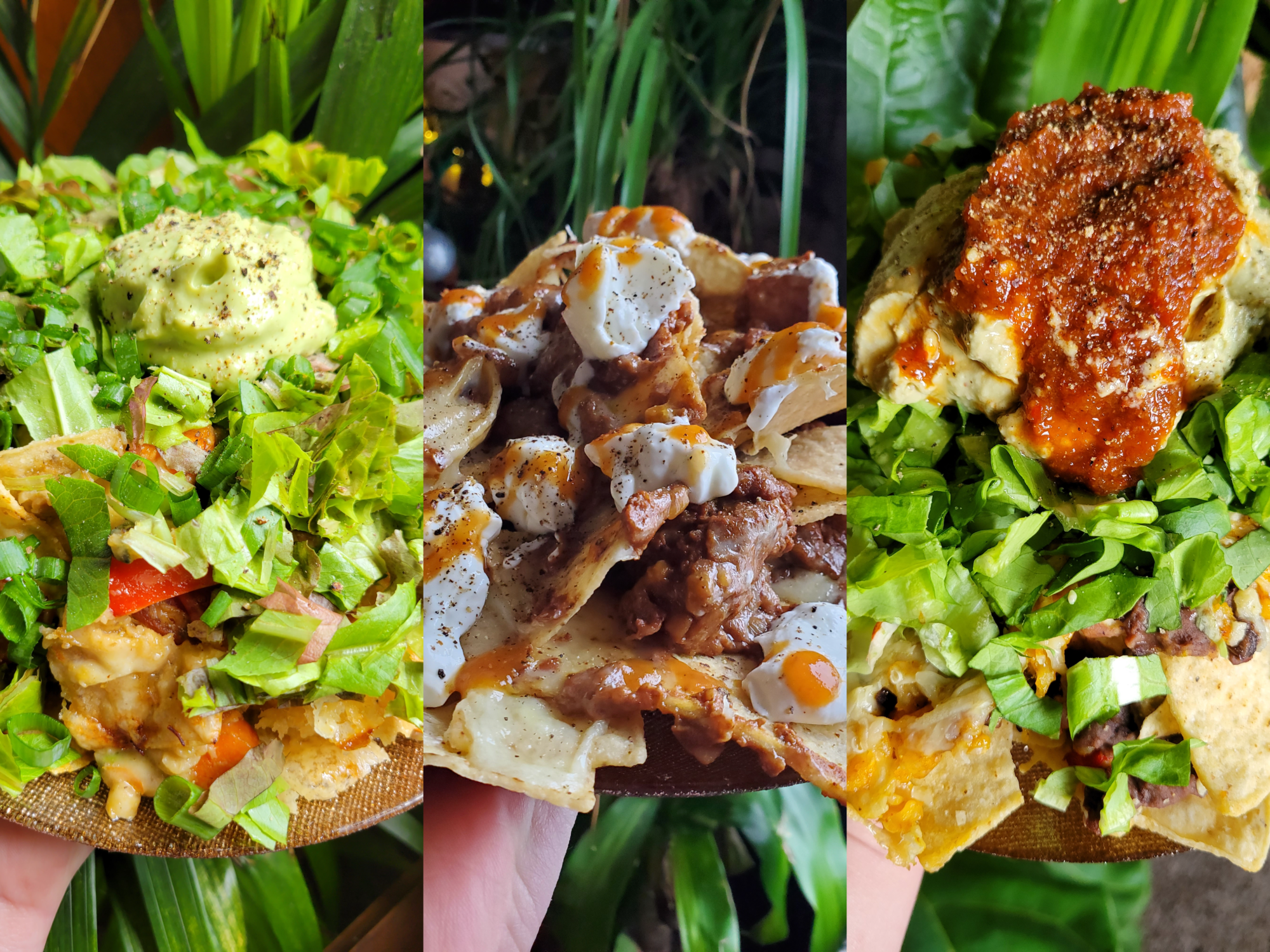

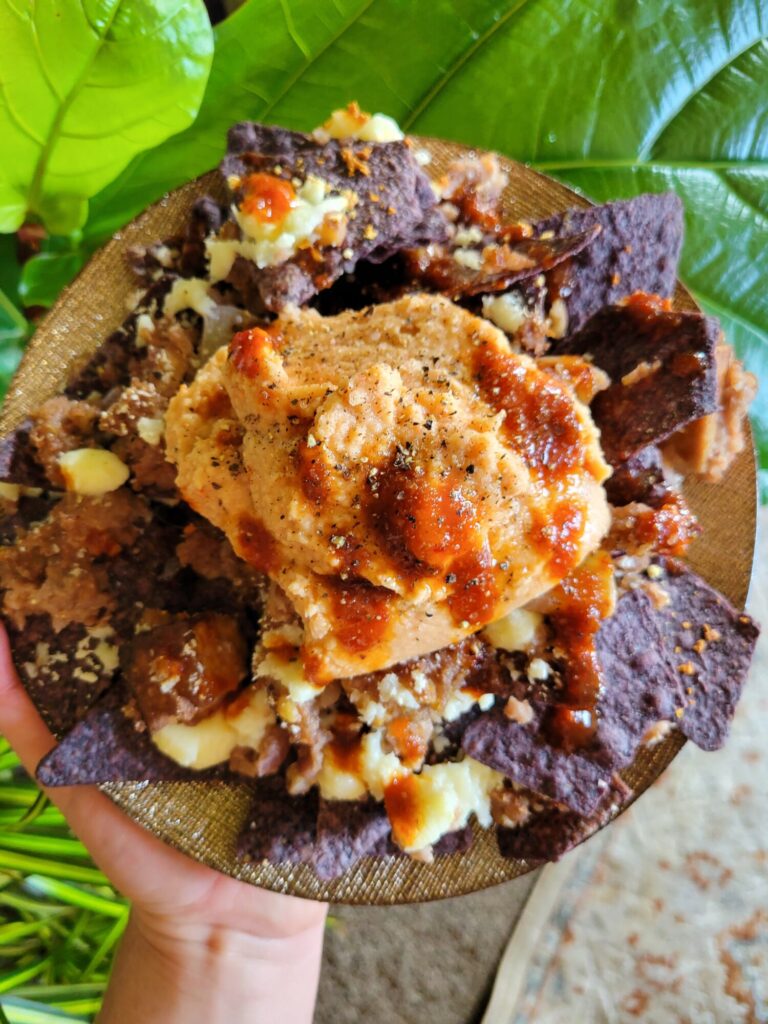


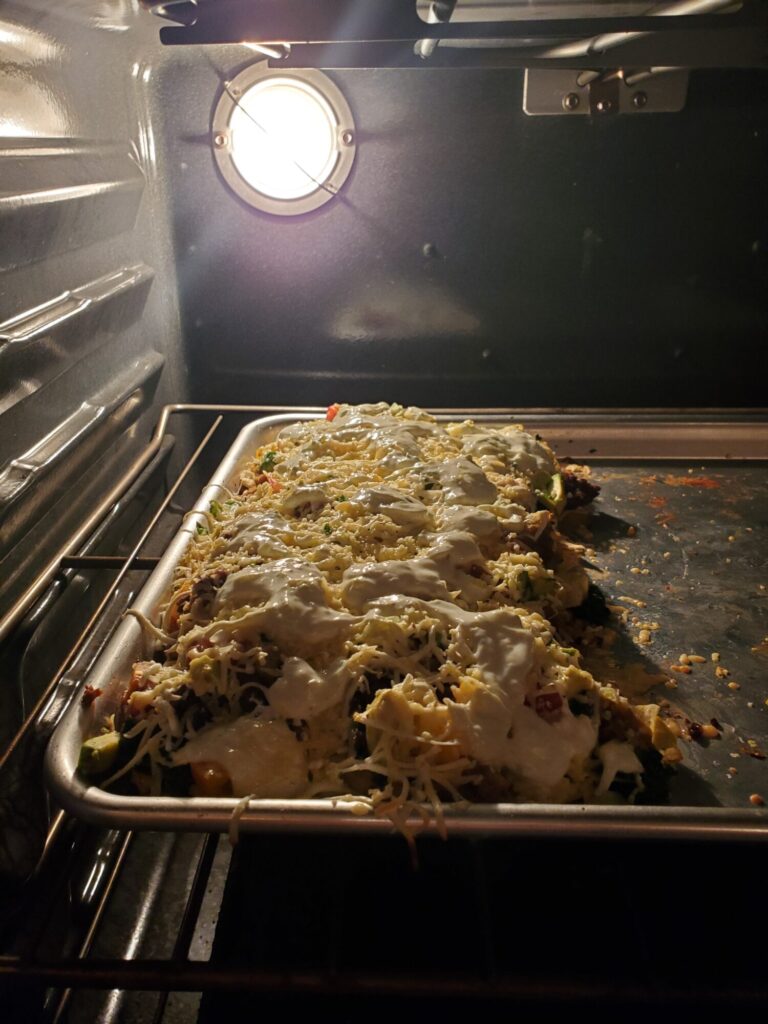
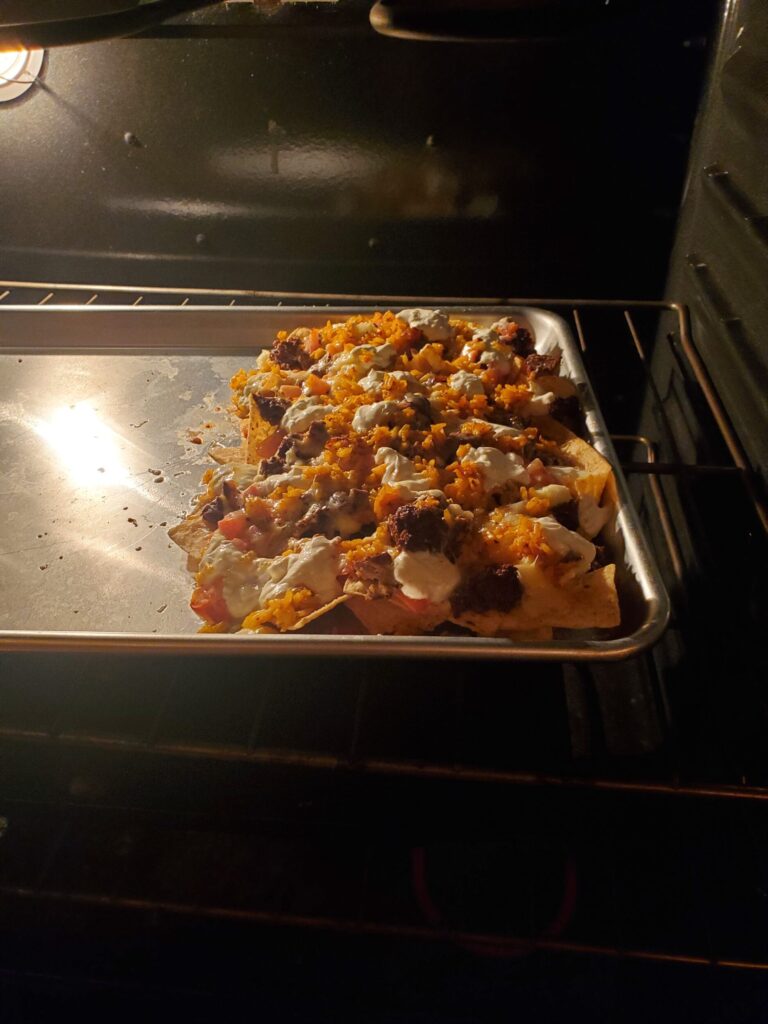
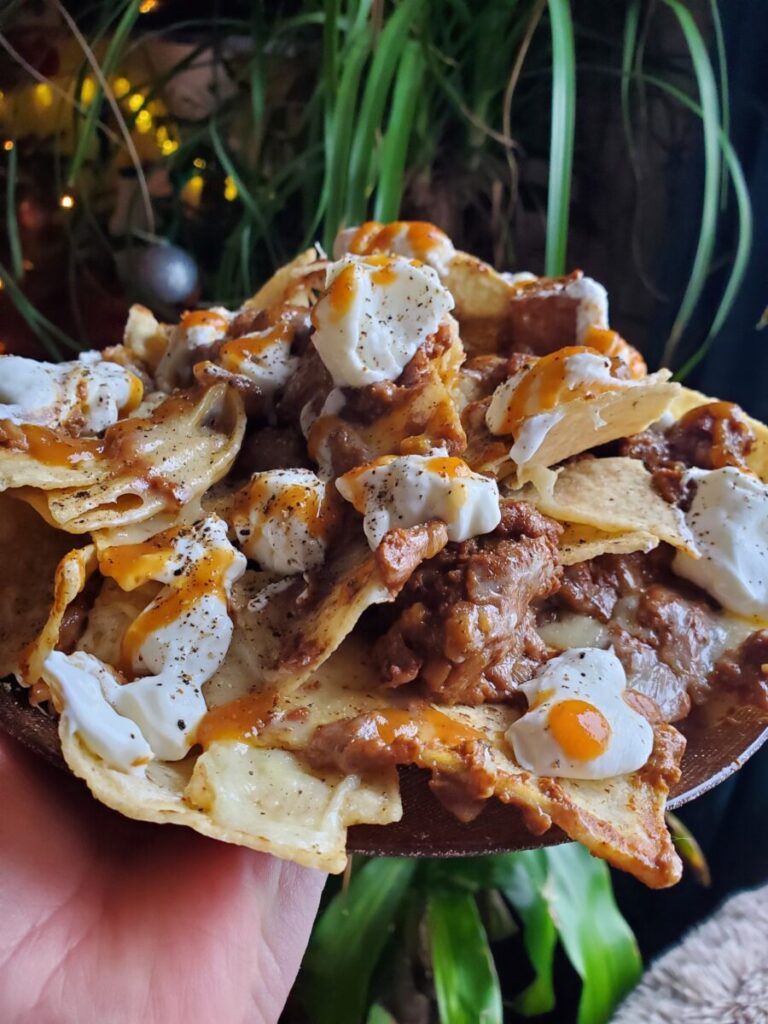
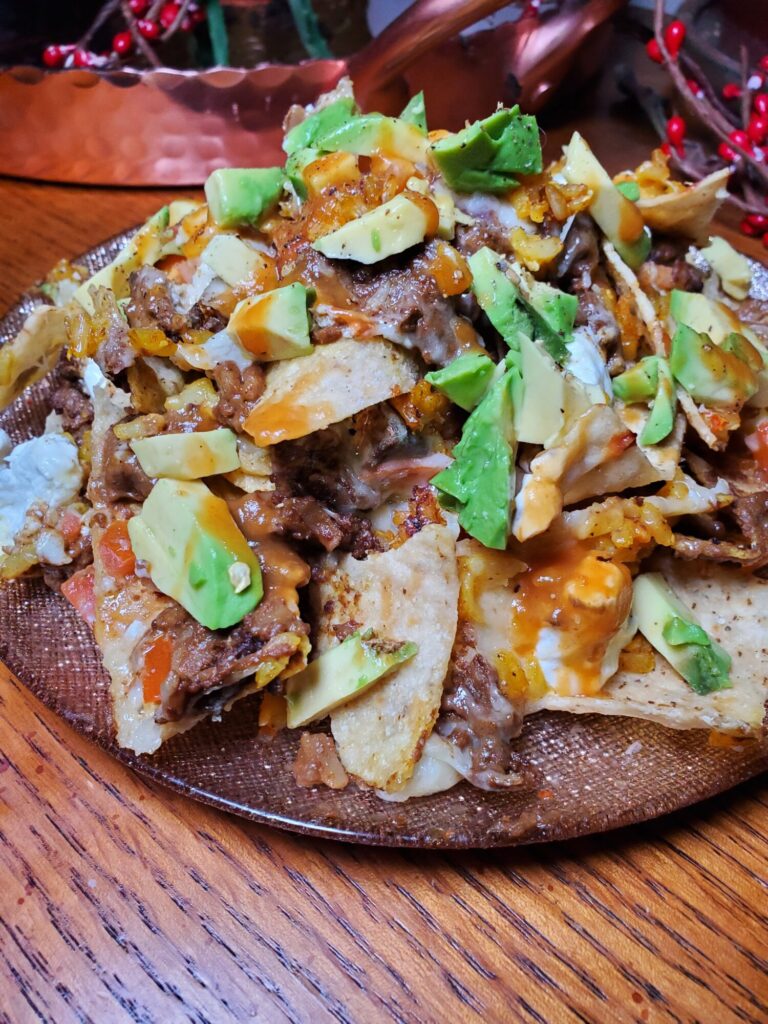
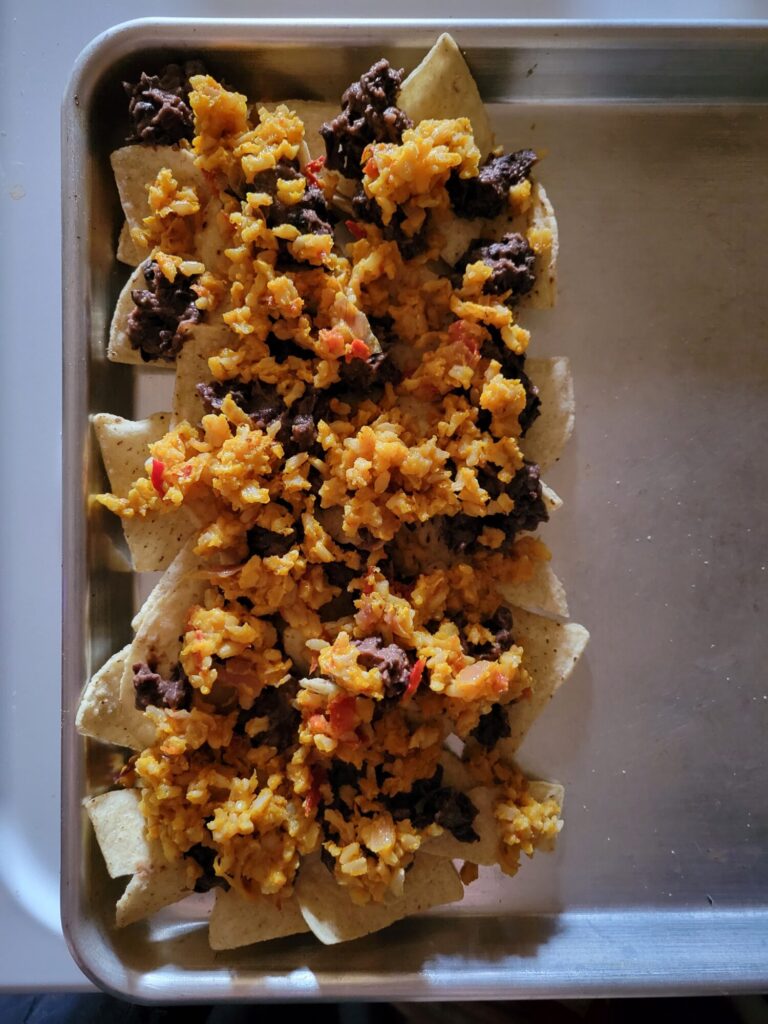


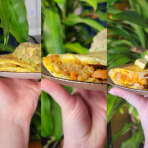
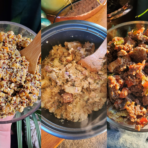
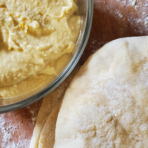




Leave a Reply